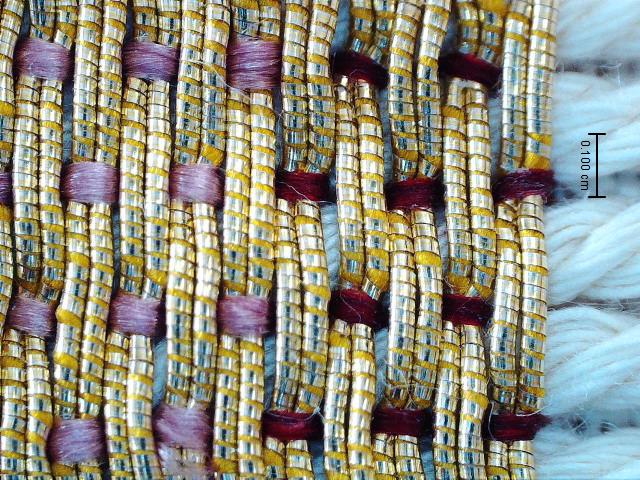|
Last week, we discovered that the use of gummy silk in medieval silk embroidery is probably not very likely. The string-like nature of the gummy fibres and its inability to 'spread' makes it an unlikely candidate for long-and-short stitch or for or nue. Today, I would like to explore another important part of medieval goldwork embroidery: couching over padding. You'll sometimes find that the silken thread used for this is described as 'slightly thicker/stronger' than the other silken threads used in the same piece. As de-gummed silk is rather slippery, using it in couching down gold threads over padding isn't easy. You just can't maintain the necessary tension when using a single couching stitch. One way around this is to use two stitches on top of each other. However, the 'coarser' nature of the gummy silk would probably do the trick too. In addition, the gum lets the silk look fatter. Let's explore! For this experiment, I laid a simple foundation of cotton threads. It is rare that the nature of the padding threads is named in the literature, but cotton padding was definitely used in some Italian embroideries in the later medieval period (for instance the 14th-century panels held at the Metropolitan Museum of Art 58.139, 1975.1.1781, 60.148.1, 60.148.2, 60.148.3, 60.148.4, 60.148.5, 61.31 & 64.27.18). With the padding in place, I proceeded with a simple basket weave using a double passing thread. This pattern is commonly seen as a frame around late medieval orphreys from the Netherlands (for instance ABM t2109). As I had expected, the gummy silks worked very well. You can tension your couching stitch and lock your gold threads in place with a single stitch. The couching stitch does not 'spring back up'. Stitching is quick and efficient. In the above picture, you'll see that the completely de-gummed silk (lightest colour) was unable to hold the gold threads down. This has resulted in a less crisp couching pattern (very difficult to photograph, but clearly visible with the naked eye). Let's see what the couching stitches look like up close. Above is a picture with couching stitches made with gummy silk (left, first 6 rows) and partly de-gummed silk (right). And here is a picture with the de-gummed silk on the left (lighter colour) and a waxed 2-ply Chinese flat silk on the right. Simply lightly waxing the silk works similarly to using gummed silk. How do these modern samples compare to medieval embroidery? It all looks incredibly similar :). As you get the same result when you wax your silk thread lightly, I have a feeling that this is the way our medieval embroiderers went. Instead of having two different types of silk in stock with the added difficulty of colour matching, I think they just used beeswax. The above pictures prove that detecting either gum or beeswax in medieval embroideries can probably not be done without chemical analysis. Thanks to Dr Katrin Kania I was able to test the idea of gummed silk in medieval embroidery. I can now back up my arguments in future discussions of the topic with some hands-on experience!
4 Comments
Alison
22/2/2022 17:00:40
Did you notice how varied the sizes/widths of the gold wraps on the gold threads are? In the center of the ABM t2107f photo, there are at least 3 strands side by side which go from narrow to medium to wide in the width of the gold metal wrap! One has to wonder if this was just the nature of the threads overall, or if there were actually differences on purpose and if that changed the overall light play from the fold.
Reply
22/2/2022 17:39:44
Yes, that's what happens when you cut the lamellae by hand with very long-bladed scissors. You will have variety no matter how hard you try. I wonder how the differences in lamella width influenced the stitching properties of the thread?
Reply
Your comment will be posted after it is approved.
Leave a Reply. |
Want to keep up with my embroidery adventures? Sign up for my weekly Newsletter to get notified of new blogs, courses and workshops!
Liked my blog? Please consider making a donation or becoming a Patron so that I can keep up the good work and my blog ad-free!
Categories
All
Archives
July 2024
|
Contact: info(at)jessicagrimm.com
Copyright Dr Jessica M. Grimm - Mandlweg 3, 82488 Ettal, Deutschland - +49(0)8822 2782219 (Monday, Tuesday, Friday & Saturday 9.00-17.00 CET)
Impressum - Legal Notice - Datenschutzerklärung - Privacy Policy - Webshop ABG - Widerrufsrecht - Disclaimer
Copyright Dr Jessica M. Grimm - Mandlweg 3, 82488 Ettal, Deutschland - +49(0)8822 2782219 (Monday, Tuesday, Friday & Saturday 9.00-17.00 CET)
Impressum - Legal Notice - Datenschutzerklärung - Privacy Policy - Webshop ABG - Widerrufsrecht - Disclaimer











 RSS Feed
RSS Feed